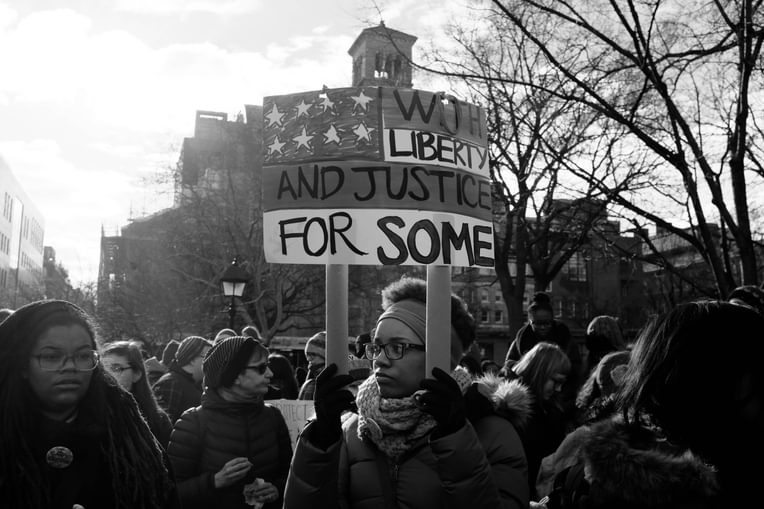Nigger Moments
From the Series: The Rise of Trumpism
From the Series: The Rise of Trumpism

What white people have to do is try and find out in their own hearts why it was necessary to have a nigger in the first place, because I'm not a nigger, I'm a man, but if you think I'm a nigger, it means you need it.
—James Baldwin
Throughout my life, I’ve regularly experienced what I think of as nigger moments—incidents that satisfy a need for violent racism. It’s disturbing when they clash with my academic world and even worse when they don’t.
A dinner several summers ago, with my brother Michael, at the home of one of his well-known senior colleagues at an Ivy League institution. The elegant house matched the man: both were monumental. Intricate masks were precisely placed all around. The soaring conversation helped cement my sense that anthropology was indeed the correct vocation for me. After several hours, Michael and I descended the sculpted driveway and strolled up the street past impressive properties, marveling at the many worlds our gracious host had crossed. Just as we neared the end of the block, I noticed a car approaching from the opposite direction. It swerved into the wrong lane and flirted with the edge of the sidewalk where we now stood still. A college-aged white man leaned out of the window and yelled, “Get out of here, you damn gorillas.” Then the car screeched off.
When I was in graduate school, once or twice a year at least, I was hit with an instance of blatant, unabashed, Bull Conner–style racism. This wasn’t simply some working-class white supremacist aggression. It was something more complex. One moment, I was visiting a friend from graduate school overseas while she was doing fieldwork. The next, I was handcuffed in a barren room at the airport, being detained by Homeland Security on the way home.
One moment, I was at a bar, casually chatting with a young white woman. The next, she is telling me that she is currently in the police academy, learning how to kill people like me.
I have countless stories like this: this kind of racism has been happening all my life. But explicit racism hit me like a splash of cold water when I was getting my PhD, I think, because of these juxtapositions: on the very same night that I was in the presence of a world-famous academic, sipping wine and getting advice about my dissertation, someone was calling me a nigger and threatening to mow me down. Soon, I learned to anticipate these nigger moments. Over time, I came to understand them as reminders to remember not to forget.

Other kinds of nigger moments continue to take a toll. Because of the lack of faculty of color in the elite spaces where I have worked, I am frequently expected to act as an expert on my own and other ethnic and racial groups. When a racially charged incident happens on campus, I find myself among the few faculty of color called upon to quell students’ or the surrounding community’s concerns. I have been celebrated by my colleagues for this mentorship and care, but within that praise was a subtle form of pressure.
Once when I was an undergraduate, my history professor showed us a lynching photo. The kind that in the early 1900s were used as postcards, circulating like coupons and collected like stamps. The professor removed the image from a folder without saying anything and projected it on the screen. A Black teenager named Jesse Washington dangled lifeless from a tree. He was lynched in Waco, Texas, accused of raping a White woman.
While looking at that picture, a long, tense shiver took hold of me, shooting up through my feet from the floor. What I felt was different from physical violence, but I felt it intensely, a queasy feeling made of despair, rage, and gnawing resentment. I could feel a glimmer of what some Black tourist, visiting the South circa 1915, might have felt when she walked into a store and saw that image perched on a news stand. Even then, I knew that the death of someone who is devalued can spark a variety of responses: sadness and shame, mocking and mourning. I was the only Black person in class that day, and therefore had the added anxiety of anticipating responses from my classmates. During the discussion, I took solace in the fact that other students were likewise sickened, not merely by the image of Washington’s body, but also by those hundreds in attendance who couldn’t contain their smiles while pointing at that poplar tree.
One white student abruptly turned away. It disturbed her too much, she said. But her reaction wasn’t based on the same feeling I had. She feared that one of the white faces in the crowd might be familiar to her. It could be one of her relatives, she said.
Just then I realized: the way we understood race lay between us like a chasm. I wondered if that chasm could ever be bridged.
If Baldwin is correct in saying that those invested in maintaining white property and privilege need the nigger, then we should ask what the nigger is needed for today. Does the president-elect need the nigger? What will nigger moments look like during the next four years? Ready or not, we’re about to find out.